
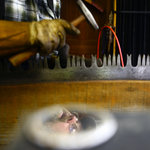
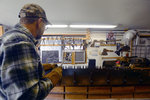
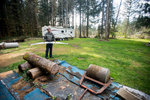
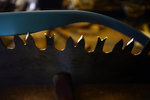
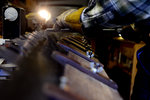

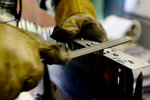
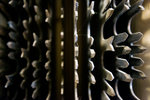
John Starling speaks of crosscut saws the way a luthier might speak of violins. Each instrument he works on has its own characteristics that, if honed correctly, can make it sing in the hands of a professional.
From inside of a small shop at his Randle home, Starling sharpens and repairs, collects and sells antique logging saws used by trail crews around the United States. Because mechanized tools aren’t allowed in wilderness areas, crews rely on the same kind of saws used before the advent of the chain saw.
Although manufacturers are still producing handsaws, antique saws — those being at least 40 years old — are highly sought after by professionals because of the superior metals they’re made from.
Indeed, a 2005 study on crosscut saws by the U.S. Forest Service says, “Modern peg-and-raker saws lack the quality of vintage saws, which are becoming increasingly difficult to find.”
“They don’t make good saw steel any more,” Starling said. “What’s out there now is left over from bandsaw steel.”
Starling built a following for himself through sharpening the saws his sons and their friends used in college logging and forestry competitions about 18 years ago. As word of his work spread, his small business clientele included schools and sawyers from California to Montana. He was still learning back then, and though even his technique is dialed in now, it hasn’t come without effort. For example, it took him about five years to develop the perfect tooth-finishing file stroke.
As a boy, Starling’s father, a carpenter, taught him how to sharpen saws. As an adult, he worked in mills around Lewis County. Now, at 61 years old, he sharpens large round and band saws as the head filer for Sierra Pacific.
“I guess it’s in my blood,” he said.
Typically he doesn’t listen to the radio as he works, preferring instead to hear his hammer rap upon steel or the grind of a file sliding up teeth.
“I’ve been around so much noise at work through the years, it’s nice to get away from it all.”
From a layman’s perspective a saw is a saw, but depending on whether it’s used to fell a tree or buck it into smaller pieces, they all can be honed to cut aggressively in the hands of an experienced sawyer or to be forgiving for a beginner; and their teeth can be adjusted by the thousandth of an inch to best cut different types of trees growing around the United States.
Starling also keeps a log of how each saw is treated before shipping it back out to its owners.
“I’ve had guys call and say a saw cut really nice this season, but not as good as it did when you filed it a few years ago, and I can go back and say, ‘Well you didn’t have as experienced of a cutting crew this year as you did back then,’” he said. “But I can change what I do in here to help make things better out there.”
Because of their rarity, Starling buys nearly every saw he can find. He’s amassed a collection of around 250 antique saws, down from the 500 or so he owned not long ago. Although they’re in their 70s, some of the saws still haven't been unwrapped. Just as the saws are rare, so too are the tools needed to care for them. Most haven’t been made in decades, so Starling has to scour the Internet and flea markets. His big concern now is figuring out how to replace his files, when he’s already bought all that he can find.
Although he’s been at it for decades, Starling doesn’t show any signs of slowing down, or getting burned out. For him maintaining antique saws marries the satisfaction of a job well done with his passion for the outdoors.
“There’s a satisfaction in knowing my work is doing something beneficial in the woods,” he said.